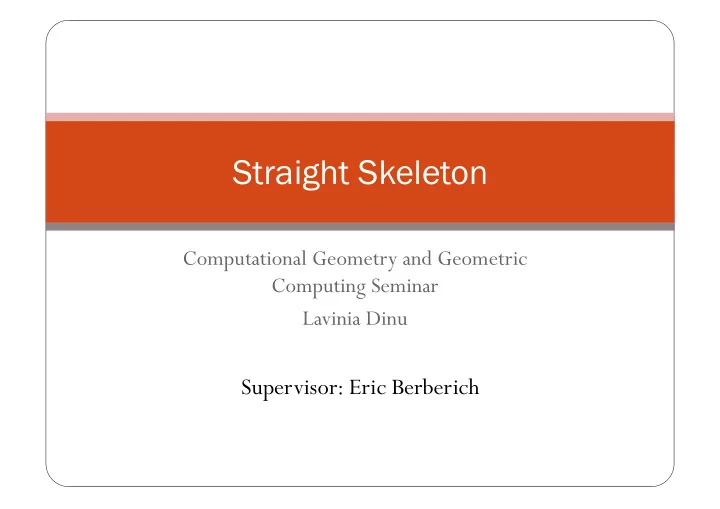

Straight Skeleton Computational Geometry and Geometric Computing Seminar Lavinia Dinu Supervisor: Eric Berberich
How to fit a roof to these walls? [SSA] Walls and fitted roof
Outline Definitions and Basic Properties A Simple Algorithm Algorithm for Polygons Applications Fold and Cut Problem Roof Design
Definitions
Planar Straight Line Graph Embedding of a planar graph in the plane Edges mapped to straight line segments No self-intersections Figures - connected components Terminals - vertices of degree one [ Wiki] A planar straight line graph Try it yourself: www.planarity.net
Skeleton Partition of plane into regions Reflects the geometric shape of the graph Arcs and nodes Medial axis – non-linear Points that have more than one closest point on the boundary [Wiki] Medial axis of a polygon
Straight Skeleton: Wavefronts Generate wavefronts Vertices move on angular bisectors Propagate wavefronts simultaneously [SSG] Polygonal figures and initial wavefronts in red
Straight Skeleton: Events Edge event Edge length decreases to zero Split event Wavefront edge splits due to interference
Straight Skeleton: Definition
Straight Skeleton: Example [SAS] Blue wavefronts and red skeleton of a polygon
Straight Skeleton: Example [SSG] Red straight skeleton of graph
Properties
Basic Algorithm
Idea
Initial triangulation
Initial triangulation Triangulation of the graph (up) and triangulation of the initial wavefronts (down) for two figures. Blue edges represent spokes, red edges wavefronts.
Flip Event [SAS] Flip Event
Edge Event [SAS] Edge Event
Split Event [SAS] Split Event
Complexity analysis
A Better Algorithm
Input Simple non-degenerate polygon Can have holes Interior polygon will have the opposite orientation [SSI] Polygon with hole
Idea & Data Structures Simulate the progression of the wavefronts Use set of circular lists of active vertices – SLAV Each LAV – loop of vertices of a wavefront Each vertex References to both neighbors References to adjacent edges in the original polygon Doubly connected circular list of active vertices Priority queue events
Convex Polygons: Initialization Store all vertices in one LAV For each vertex Add reference to the two incident edges Compute the angle bisector Compute nearer intersection of bisector with adjacent ones Add to priority queue Sort by distance to the corresponding edge Add reference to the corresponding vertices Can be duplicities among the intersection points
Convex Polygons: Initialization [SSI] Initialization
Convex Polygons – Loop Part 1
Convex Polygons – Loop Part 2
Convex Polygons – Loop Part 3 [SSI] First Step
Non-convex Polygons Add event type attribute Edge event or split event Reflex vertices can cause both types of events [SSI] Reflex vertices causing edge event A and split event B
Determine split events [SSI] Split event and feasible area
Processing split events [SSI] Updating the LAVs
Complexity Analysis
Applications
Applications Decomposition of concave polygons into convex regions Preprocessing step for shape matching, Minkovski sum Interpolating polygonal curves Fold and cut problem Roof design Terrain reconstruction
Fold and Cut Problem Fold a piece of paper and cut along a line Any possible shape can be obtained Creases are: The straight skeleton Perpendicular lines to the given shape reflected at the skeleton [PR] Applet to generate the folds
Fold and Cut Problem [FC] Fold Pattern for a figure
Roof Design: Hip Roof All facets have the same slope Algorithm: Construct straight skeleton Determine distance of each vertex from supporting edge Determine roof planes Raise vertices accordingly Can be adapted for different slopes Change propagation speed of wavefronts
Roof Design: Hip Roof [AGF] Steps for creating a hip roof
Roof Design: Gable Roof Has an small gable on top Algorithm Find a vertex created by bisectors from the original polygon Move it to the midpoint of the [Wiki] Gable roof supporting edge [AGF] Creating a gable roof
Summary
Sources [SSG] O. Aichholzer, F. Aurenhammer. Straight Skeleton for General Polygonal Figures in the Plane [ANT] O. Aichholzer, F. Aurenhammer, D. Alberts, B.Gaertner. A Novel Type of Skeleton for Polygons [SSI] P . Felkel, S. Obdrzalek. Straight Skeleton Implementation [AGF] R. G. Laycock, A. M. Day. Automatically Generating Roof Models from Building Footprints [SAS] D. Eppstein. A Subquadratic Algorithm for the Straight Skeleton [FC] http://erikdemaine.org/foldcut/ [PR] http://cgm.cs.mcgill.ca/~athens/cs507/Projects/2003/EricBiunno/ [Wiki]Wikipedia
Thank you for your attention! Questions?
Recommend
More recommend